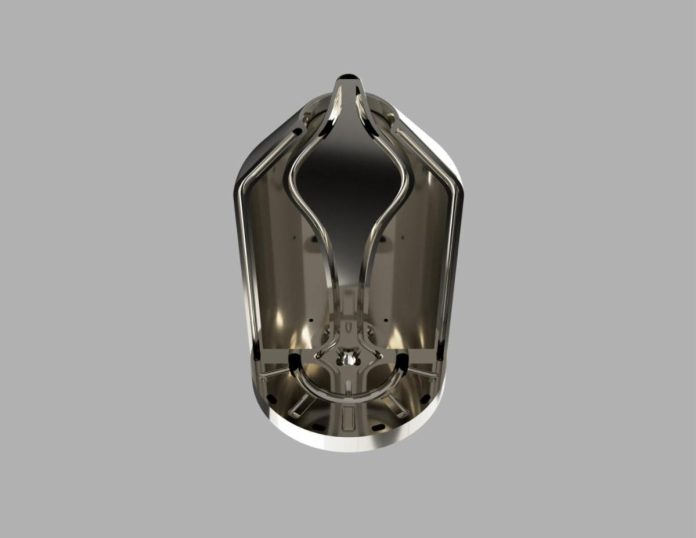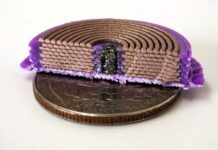
Media Release by Parker Group
With shortened classroom time due to the country’s Covid lockdown, U.K. high-school student Ewan Craig finished required studies early and turned his attention to an old pastime: understanding rockets. Using free afternoons and evenings, Ewan, then 16, dove into the mysteries of propulsion and all things aerospace.
He signed onto a Massive Open Online Course (MOOC) offered by MIT, a free graduate-level introductory program on aerospace. There, Ewan had access to textbooks for older and more formally educated students than himself. The reading was an eye-opener: What grabbed him was research from the 1950-60s on a rocket system called the aerospike, first undertaken by Rocketdyne Propulsion & Power, a unit of The Boeing Company of California.
The fact that the engine had never been commercially developed, despite others having a go at it, intrigued Ewan—and his journey to understand why began.
A rocket engine no one can make
The aerospike was conceived as a one-stage engine that could maintain aerodynamic efficiency throughout its flight by adapting to the changing altitudes of the craft it thrust into space. A vehicle with an aerospike engine uses 25–30% less fuel at low altitudes, where most missions have the greatest need for thrust; as a result, it can launch without boosters—a key time and cost-saver.
Aerospike engines have been studied for decades, are the baseline engines for many single-stage-to-orbit designs, and were also a strong contender for the Space Shuttle main engine. However, no such engine is in commercial production, although some large-scale aerospikes are currently in testing phases.
Technical challenges persist in creating an economical and manufacturable aerospike that can overcome the cooling issues inherent in its high-performance design. As a result, the proven, multi-stage Bell thruster remains the engine-of-choice for most launch vehicles. Ewan felt compelled to try and change this narrative.
When math answers the questions
“I’ve always been fascinated by mathematics, from primary school onward,” says Ewan. “It’s such a logical, wonderful space that exists in a context beyond everything else that we do in our lives. To do something that’s real, and always get it right, is absolute. You’re not going to be halfway right, or right in one point of view but wrong in another. It helps solve problems. It underpins so much of what physicists do and what engineers do and what architects do. I just love it. I think it’s kind of a building block of everything that we do as scientifically-minded people.”
Ewan had a physics teacher in high school “who really put me on to math. He would say, ’There are real-world things you can do and here are equations that are going to predict what happens.’ My gosh. It’s worked. When you see the possible applications. When you can predict something, and see it happen in real life exactly as you anticipated. That’s always quite impressive.”
Partners in the love of math
As Ewan explored his own versions of an aerospike design through computer-aided-design (CAD) programs available at school, his work snowballed from rough sketches into a genuine idea. But he found he needed more range and complexity from his CAD system in order to move his designs forward. They contained a maze of channels and fluid boundaries that demanded enterprise-grade software beyond the school’s basic offerings.
“After I’d been doing loads of design work, and trying to calculate how I could keep the engine cold and whether it would actually produce any thrust, and how the fluid dynamics inside would work, I realized that I couldn’t do that by pen and paper alone,” says Ewan. “You have to model it computationally using CFD (Computational Fluid Dynamics) software. But the issue for me was that all the free, open-source software is for handling simple components and behaviours. By this point, my model had already reached six or seven million DOF (Degrees of Freedom).” He formed his own company, CEA Space (Connect Everything Aerospace), and kept going.
Enter Ansys. Ewan reached out to the software provider through their contact page, hoping to unlock a few extra features or get a free-trial tool to meet his needs. Instead, Ansys got back to him directly via their partner EDRMedeso in the Advanced Manufacturing Park Technology Centre in South Yorkshire. Ansys has a Startup Program suited exactly to Ewan and other engineer’s needs. The EDRMedesco rep told Ewan they thought they could do one better than just upgrading his software. So began a helping-hand relationship that introduced Ewan to high-end modeling and simulation—plus more.
Time to print
With Ewan’s aerospike design now on the fast track, it was time to look toward manufacturing the engine. But, similar to the results with Ewan’s initial outreach to CAD vendors before the Ansys offer, the manufacturing companies he contacted all wanted significant money for their services. Serious costs were not in the cards for this high-school student, however.
“I reached out to several 3D metal print manufacturers in order to understand what was possible,” says Ewan. “There was not much assistance given of any type. People quoted me 30, 40-thousand pounds sterling for a single print. The other issue was their saying that they couldn’t do the aerospike print at all. That it was a nightmare.”
Ansys then told him they had another company for him to consider. “They sent me a link to the Velo3D website, saying, ‘Do you think these guys’ capabilities would work?’ Ewan recalls. “I trawled through their website, did all the research I could and concluded they looked absolutely ideal.”
Ewan contacted Velo3D online. The result was just as quick and unequivocal as with Ansys. Soon thereafter, Velo3D engineers were helping the UK student with design suggestions and the offer of a free test print.
“They proposed ways that I could manage and optimize the model,” says Ewan. “I’ve been able to go into my CAD program and modify and make those changes and return the design back for feedback. And they would then say, ‘Yeah. That’s perfect,’ or, ‘Well, maybe try this instead.’ Every step of the way, they’ve been thinking about how we can get the aerospike to work properly, the way I envision—which, as a technical partner with a company, is exactly what you want.”
From Velo3D’s perspective, working with Ewan was just as smooth and collaborative. “He was very open to suggestions from the beginning,” says Ben Wilson, Applications Development Engineer for Velo3D. “With the capabilities of our AM system, we didn’t need to make overly invasive modifications to the original part in order to make it printable. Ewan would provide a model, then we would make minor suggestions to improve the printability and reduce the amount of post-processing needed. After a few iterations, we had a rocket that could be printed successfully without any manual support removal needed.”
According to Wilson, Ewan’s aerospike design was well suited to Velo3D’s automated print software, Flow, which can address challenging geometries and features up-front, without multiple test iterations and adjustments. “The manifold ring, where all of the passages converge, is a mid-sized circular passage that is routed in a complete circle around the part,” says Wilson. “This passage alone would be very difficult to print on another system without supports or significant modifications. The closures at the tops of passages would likely be very rough on other systems and may have some partially melted particles that are prone to falling off as FOD (Foreign Object Debris) in operation.”
Doing away with DfAM
Ewan’s aerospike design is decidedly faithful to the original 1960s vision of a one-piece rocket engine. “An aerospike needs to be created from the ground up as a single part or the physics of the rocket thruster are undermined,” Ewan says. “Here is where my design differs from other earlier and even current efforts. It’s built as one-piece, taking all the multi-part complexity out, making it as simple as possible so it will be viable.”
In avoiding Design for Additive Manufacturing (DfAM) rules that compromise many advanced designs in order to meet conventional AM manufacturing limitations, Ewan hopes to have reached a solution to the high-heat problems that have grounded aerospikes to date.
“The fact that this project is printed out of one piece means that to cool the walls of the combustion chamber and central aerospike, fluid needs to be flowing through the walls themselves,” he says. “This requires channels, and a channel inside of a channel—basically an unsupported wall within an unsupported wall. Well, that was deemed very much impossible by quite a few people I had gotten in touch with.
“My aerospike design also has large overhangs and really narrow wall geometry. Low-angle walls are critical to maintaining constant cooling pressure within those channels—so necessary for performance and survivability.”
Hopeful for the changes ahead
With his design optimized and printed, Ewan’s aerospike engine will soon be test-fired at an American university that contributes to progress in science and aerospace. As he awaits that next step, Ewan reflects on the future.
“Advanced 3D metal printing will open a new age in economical, scalable manufacturing for space,” he says. “Rockets can be built quickly. Programs can accelerate. More payloads can be delivered such as nano stats, CubeSats and the like. Costs will fall.
“If you can provide an affordable solution to propulsion for launch vehicles, which I believe AM can, then there is a greater opportunity for smaller businesses to make breakthroughs in space travel and commercial aerospace. I’m very hopeful about the changes ahead—and for engineers like myself to be invited to make a potential impact.”



















